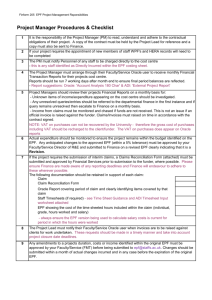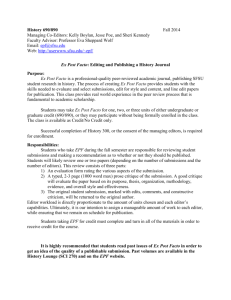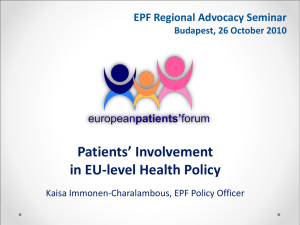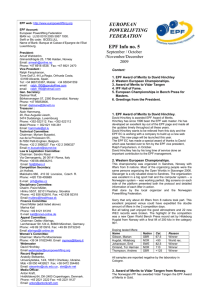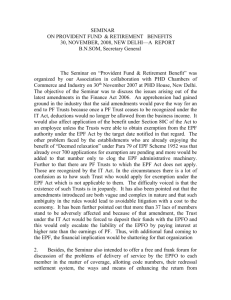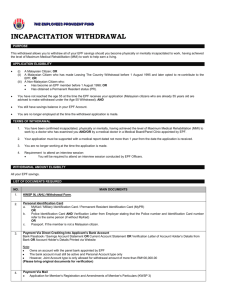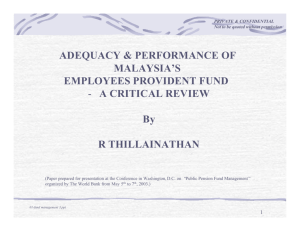EPF - UNICEF Humanitarian Action Resources
advertisement
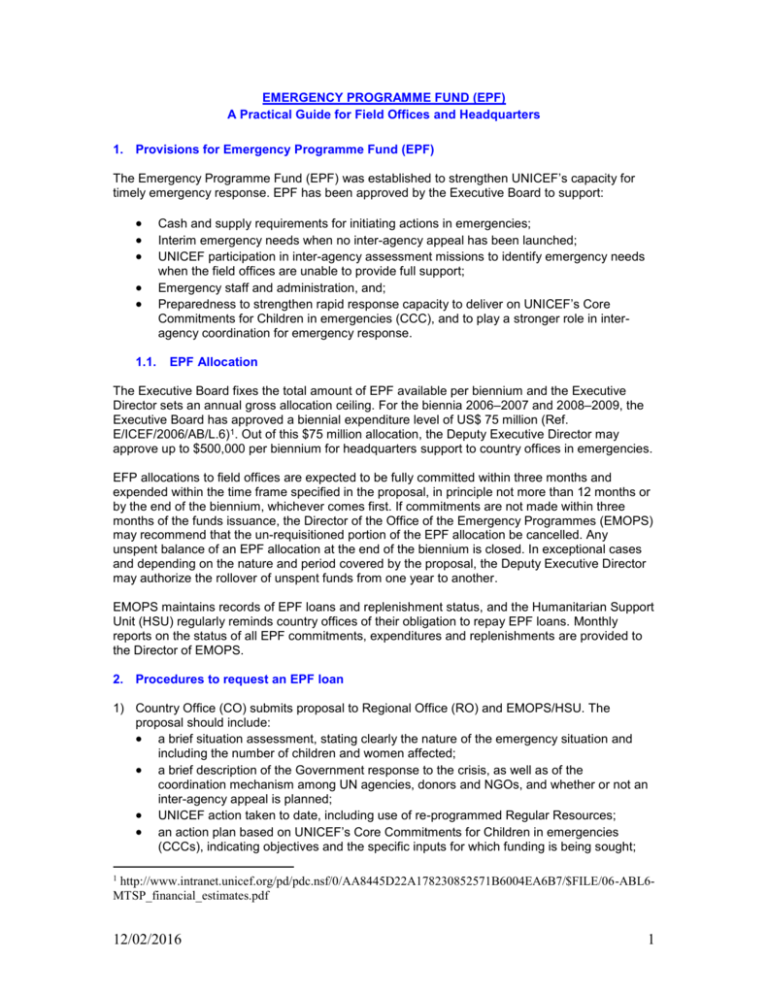
EMERGENCY PROGRAMME FUND (EPF) A Practical Guide for Field Offices and Headquarters 1. Provisions for Emergency Programme Fund (EPF) The Emergency Programme Fund (EPF) was established to strengthen UNICEF’s capacity for timely emergency response. EPF has been approved by the Executive Board to support: 1.1. Cash and supply requirements for initiating actions in emergencies; Interim emergency needs when no inter-agency appeal has been launched; UNICEF participation in inter-agency assessment missions to identify emergency needs when the field offices are unable to provide full support; Emergency staff and administration, and; Preparedness to strengthen rapid response capacity to deliver on UNICEF’s Core Commitments for Children in emergencies (CCC), and to play a stronger role in interagency coordination for emergency response. EPF Allocation The Executive Board fixes the total amount of EPF available per biennium and the Executive Director sets an annual gross allocation ceiling. For the biennia 2006–2007 and 2008–2009, the Executive Board has approved a biennial expenditure level of US$ 75 million (Ref. E/ICEF/2006/AB/L.6)1. Out of this $75 million allocation, the Deputy Executive Director may approve up to $500,000 per biennium for headquarters support to country offices in emergencies. EFP allocations to field offices are expected to be fully committed within three months and expended within the time frame specified in the proposal, in principle not more than 12 months or by the end of the biennium, whichever comes first. If commitments are not made within three months of the funds issuance, the Director of the Office of the Emergency Programmes (EMOPS) may recommend that the un-requisitioned portion of the EPF allocation be cancelled. Any unspent balance of an EPF allocation at the end of the biennium is closed. In exceptional cases and depending on the nature and period covered by the proposal, the Deputy Executive Director may authorize the rollover of unspent funds from one year to another. EMOPS maintains records of EPF loans and replenishment status, and the Humanitarian Support Unit (HSU) regularly reminds country offices of their obligation to repay EPF loans. Monthly reports on the status of all EPF commitments, expenditures and replenishments are provided to the Director of EMOPS. 2. Procedures to request an EPF loan 1) Country Office (CO) submits proposal to Regional Office (RO) and EMOPS/HSU. The proposal should include: a brief situation assessment, stating clearly the nature of the emergency situation and including the number of children and women affected; a brief description of the Government response to the crisis, as well as of the coordination mechanism among UN agencies, donors and NGOs, and whether or not an inter-agency appeal is planned; UNICEF action taken to date, including use of re-programmed Regular Resources; an action plan based on UNICEF’s Core Commitments for Children in emergencies (CCCs), indicating objectives and the specific inputs for which funding is being sought; 1 http://www.intranet.unicef.org/pd/pdc.nsf/0/AA8445D22A178230852571B6004EA6B7/$FILE/06-ABL6MTSP_financial_estimates.pdf 12/02/2016 1 likelihood of external funding availability to replenish the EPF loan. 2) RO reviews and endorses the request; 3) HSU ensures HQ review involving relevant Divisions; 4) HSU submits recommendation of EPF loan for endorsement by Directors of Programme Division (PD), Office of Emergency Programmes (EMOPS), and Programme Funding Office (PFO) and approval by the Deputy Executive Director; 5) Following signature of Deputy Executive Director, EMOPS requests Division of Financial and Administrative Management (DFAM) to issue a Programme Budget Allocation (GE PBA); 6) DFAM releases the funds to the Country Office. 7) The EPF use should be reported on in the CO Annual Report (see PPP Manual). 3. Procedures to replenish an EPF loan When Other Resources (OR) funds are received that can replenish EPF, the recipient Country Office should reverse charges from EPF to the OR funding source. Headquarters (HQ) should be immediately notified, so that the EPF loan can be reduced accordingly and/or cleared. For more details on this process, please refer to the Budget Instruction No. 2001/03 of 14 June 2001. Allocations from the EPF are primarily made as loans to eligible field offices in anticipation of receiving donor contributions. If no such donations are received, as sometimes occurs in lifethreatening situations, the Director, EMOPS may authorise the conversion of the original EPF loan into a permanent, non-reimbursable grant from the EPF. 4. Conversion to Non-Reimbursable Grant On a case-by-case basis, and pending verifiable and satisfactory justification, country offices may submit a conversion request to EMOPS-HSU, which will make then review requirements, funding and implementation rates and subsequently make a recommendation to the Director, EMOPS for a final consideration and appropriate decision. 5. Procedures for Headquarters EPF HQ Divisions and support systems are often called upon to assist country offices. The nature of emergencies means that this support is often difficult to budget in advance. Five Hundred Thousand USD of EPF funds in each biennium is authorised on a non-reimbursable basis for HQ support in these areas: Provide immediate programmatic and technical support; Support needs assessments to identify programme priority in line with the CCCs; Support formulation of CAP in line with UNICEF programme policy; Ensure staff security concerns are addressed, including assessment of security situation; Support staffing requirements, through the rapid screening, identification and deployment of technical experts and emergency personnel in both programme and operational areas; Identify IT/TC needs from the very inception of a crisis; Provide short-term staffing and consultancy requirements for media related work; Provide support to country offices in mobilisation and management of emergency funds; Support supply and logistics planning and other operational issues in country offices. 12/02/2016 2

